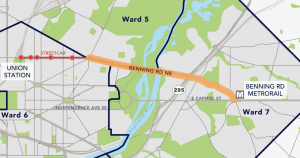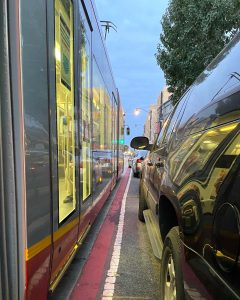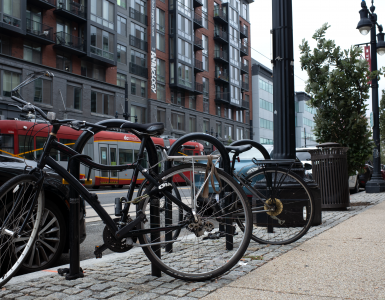Later this month, the District Department of Transportation will present the final design of the D.C. Streetcar’s 2.2-mile expansion onto Benning Road in Northeast D.C. The new streetcar track will connect to the pre-existing 2.4-mile leg of the streetcar on H Street NE, which was completed in 2016 and has faced criticism and threats to funding since then.
In addition to extending the streetcar and connecting it with the Benning Road metro station, the DDOT project will also reconstruct bridges and enhance bicycle and pedestrian facilities along the roadway. The final design phase will conclude in spring of 2022 and construction will begin in spring of 2023. The project is estimated to cost just over $178 million, with anticipated completion in 2025 or 2026.

Delia Houseal is the vice president of the Friends of the D.C. Streetcar. This advocacy group focuses on the expansion of the streetcar east of the Anacostia River, something Houseal said is essential for “transportation equity.”
For Houseal, transportation equity means the “unfair distribution of transportation resources, services, policies [and] infrastructure” and “transportation equity is the need to make sure that those resources are distributed in a way that is fair and does not disadvantage any population.”
According to Michael Havlin, president of the Friends of the D.C. Streetcar, the Benning Road streetcar expansion would serve 37,000 Ward 7 residents living within walking distance of the proposed new streetcar stops. These residents currently live in what Havlin called a “transportation desert” and do not have easy access to transit or to the rest of the city.
“Ward 7 is isolated and separated from the rest of the District,” Havlin said. “We need permanent infrastructure that unites instead of divides right now […] When you look at the history of transit planning in D.C., it’s pretty clear that Wards 7 and 8 were intentionally separated from the rest of D.C.”
Houseal and Havlin both said that it’s important that the solution to this transportation desert take the form of the streetcar extension rather than a bus. To them, the streetcar represents a permanent system, while bus routes can be changed and removed.
“It’s just about having permanent infrastructure,” Houseal said. “Regardless of fluctuations in the budget, it’s there. They can’t completely strip it away.”

Houseal said that even though her neighbors in the Benning Road area would benefit most from the streetcar expansion, she’s heard a mix of responses from her community as the project has continued.
Many of her neighbors fear that running the streetcar down Benning Road will lead to further gentrification of the Northeast. Houseal reminds them that “the streetcar does not cause gentrification; what causes gentrification is the lack of affordable housing options.”
Despite Houseal’s rejection of this argument, concerns about the existing D.C. Streetcar and gentrification have been widespread since the streetcar’s inception, with many of H Street’s new, luxury apartments appearing concurrently with the streetcar’s arrival.
Gentrification is just one of the many concerns voiced by critics of the current H Street NE streetcar and DDOT’s plans for its expansion. Other frequently cited complaints are that the streetcar is too slow and contributes to traffic on H Street NE.
Rhea Rossiter Koziatek has lived in the H Street NE neighborhood for two years and said when she first moved to the area, she had “very high hopes for the streetcar” but since then has found it to be “very underwhelming.”
The D.C. Streetcar does not have its own lane on H Street NE and is confined to the right-most lane of traffic in either direction. This means the streetcar shares a lane with cars and must obey the same traffic laws as the rest of traffic. Koziatek said it also means the streetcar is, “constantly getting stuck behind cars illegally parked in the lane.”
There are two @DCStreetcar trains stuck behind this extremely privileged and entitled @MD_Driver_in_DC.
I asked him very nicely to move while emphasizing the trains but he’s not having it. @311DCgov @DDOTDC please help. pic.twitter.com/w3FGOMTs7c
— Robb Dooling (@Robb4DC) October 13, 2021
Connor Garvey, another resident of the H Street NE neighborhood, said running the streetcar in the right lane of traffic makes it “by far one of the slowest options of travel because it competes with inconsiderate drivers.”
Other complaints about the D.C. Streetcar have come from high places, including a 2020 effort by D.C. councilmember at-large and mayoral candidate Robert White to defund expansion and redirect $35 million in streetcar funding to fix public housing issues. White’s motion was ultimately defeated within the D.C. Council, but by a narrow margin.
Despite its controversy, the current stretch of streetcar on H Street NE serves an important purpose for its users, who ride the streetcar free of charge, though ridership has decreased during the pandemic.
According to the acting director of DDOT, Everett Lott, between Feb. 2016 and Feb. 2021, the D.C. Streetcar carried more than 4.4 million passengers to destinations along H Street NE.
Before the pandemic, the streetcar served 3,000 passengers a day, on average. In an email statement, Lott said “ridership dropped significantly during the public health emergency,” and the “streetcar currently averages 1,000 passengers a day, but ridership continues to increase as the city reopens.”
For neighborhood resident Vernita Brown, the traffic obstacles do not outweigh the convenience of a free ride on the streetcar. Brown said the streetcar is “great for just running down the street to the Giant grocery store” and making other stops along H Street NE.

As the Benning Road expansion project continues, its current design includes plans to run the streetcar down the center of the six-lane boulevard, rather than in the right-most lane, eliminating traffic issues cited most frequently with the H Street NE streetcar.
The Benning Road project is expected to break ground in spring 2023, but both Houseal and Havlin said they are only cautiously optimistic about that timeline.















Add comment